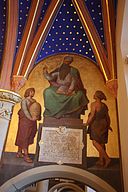 John Chrysostom (d. 407) came from Antioch and was such a great preacher that he earned the name “Chrysostom” (golden mouth). Chrysostom was influenced by the so-called Antiochene school, because he sat under the teaching of Diodore of Tarsus, a well-known Antiochene teacher. Although Chrysostom benefited from the teaching of Diodore, it would not be accurate to classify him as an Antiochene teacher, because he maintained an orthodox Christology. The true Antiochenes were eventually condemned as heretics due to problems with their Christology (Fairbairn, 10-11).
John Chrysostom (d. 407) came from Antioch and was such a great preacher that he earned the name “Chrysostom” (golden mouth). Chrysostom was influenced by the so-called Antiochene school, because he sat under the teaching of Diodore of Tarsus, a well-known Antiochene teacher. Although Chrysostom benefited from the teaching of Diodore, it would not be accurate to classify him as an Antiochene teacher, because he maintained an orthodox Christology. The true Antiochenes were eventually condemned as heretics due to problems with their Christology (Fairbairn, 10-11).
Chrysostom, like his teacher Diodore, is skeptical of allegorical interpretation. He focuses instead on the literal sense and makes use of a “fuller sense” (theōria) that steers away from allegorical interpretation. Chrysostom’s “fuller sense” includes typology. He provides a number of helpful examples of typological interpretation. It is therefore interesting to see how Chrysostom interprets Galatians 4:21-31.
Galatians 4:21-31 is an important passage in the debate over the distinction between allegorical interpretation and typology. In my previous post, I cited Galatians 4:24, which says, “Which things are allegorical (or speaking allegorically, allēgoroumena), for these women represent two covenants, one is from Mount Sinai…this is Hagar.” This is the only place in the New Testament where terminology that is often associated with allegorical interpretation occurs. When Origen cites Galatians 4:21-24 in On First Principles (book 4, section 13), he says that Paul indicates that “an allegorical meaning underlies what is written.” On the other hand, when Chrysostom speaks about Galatians 4:24, notice that he clarifies that Galatians 4:21-31 provides an example of typology.
Here is an excerpt from Chrysostom’s homily on Galatians (on Galatians 4:24):
“‘Which things contain an allegory’ (Galatians 4:24). Contrary to usage, he calls a type an allegory; his meaning is as follows; this history not only declares that which appears on the face of it, but announces somewhat farther, whence it is called an allegory. And what hath it announced? No less than all the things now present.”
Due to his Antiochene teachers, Chrysostom is a Church Father who can distinguish between typology, allegory, and the allegorical interpretation of Philo and Origen. In his interpretation of Galatians 4:24, he seems to be saying that even though Paul uses the language of allegory, his interpretation of the Old Testament in Galatians 4:21-31 is really an example of typology rather than an example of an allegory. Paul says that his interpretation contains “an allegory,” because it has a deeper meaning (“announces somewhat further”). However, the deeper meaning is really an example of typology and not an example of the type of allegorical interpretation that one finds in Philo and Origen.
Sources:
Primary sources: Excerpt from Chrysostom taken from Nicene and Post-Nicene Fathers, 1st series, Vol. 13; Origen, On First Principles is available from NewAdvent.org.
Fairbairn, Donald. “Patristic Exegesis and Theology: The Cart and the Horse,” Westminster Theological Journal 69 (2007): 1-19.
Hill, R. C. St. John Chrysostom: Commentary on the Psalms, vol. 1. Brookline, MA: Holy Cross Orthodox Press, 1998.
Mitchell, M. “John Chrysostom.” In Historical Handbook of Major Biblical Interpreters, ed. D. McKim, 28-34. Downers Grove: InterVarsity, 1998.